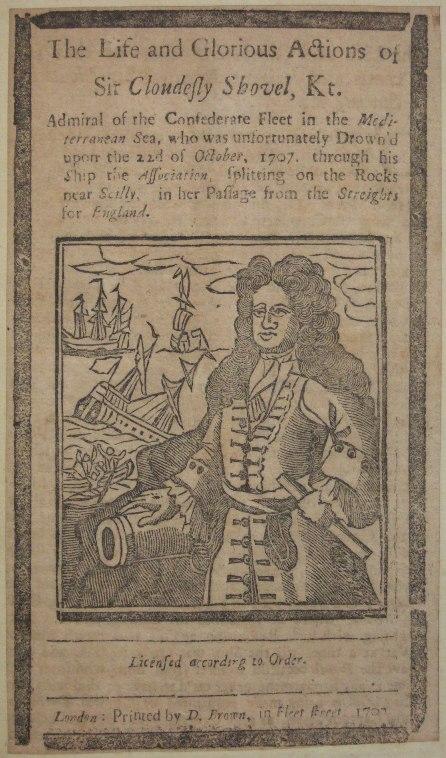Essential Information
| Location |
Royal Observatory
|
|---|---|
27 Oct 2014
To Day came in Her Majesty’s Ships the Royal Anne Sir George Bing Commander, the Torbay Sir John Norris, the St. George Lord Dursely, the Somerset, Orford, Swiftsure, Monmouth, Panther, Rye, Cruiser, Vulcan Fireship, Weasel, and Isabella Yacht. They bring the bad News of Sir Cloudsly Shovel’s being lost in the Association on the Rocks of Scilly the 22d Instant about 8 at Night.A slightly more detailed report came in the same newspaper on 1 November of:
an Account, that Sir Cloudsly Shovel with about 20 Sail of Men of War coming from the Streights, having made an Observation the 21st, lay the 22d from 12 to about 6 in the Afternoon; but the Weather being very hazy and rainy and Night coming on dark, the Wind being S.S.W, they Stearing E by N, supposing they had the Channel open, were some of them upon the Rocks to the Westward of Scilly before they were aware, about 8 a Clock at Night. Of the Association not a Man was sav’d ... The Captain and 24 Men of the Firebrand Fire-Shop were saved, as were also all the Crew of the Phoenix. ’Tis said the Rumney and Eagle, with their Crews, were lost with the Association.Similar accounts appeared in other newspapers and were equally factual in their reporting. Shortly after the wreck some brief accounts of Shovell's life, mourning his loss, were also published. Two of them included a longish poem with the lines:
O! dreadful Accident, be silent Fame And tell us not how, nor by what Chance it came, The Shrieks and doleful Cries forbear to name, A dismal Fog obscur’d the dang’rous Coast, And on the Rocks the Association tost, Where Shovel and Eight Hundred Souls were lost;If there was any speculation at all about the causes, it seemed to focus on the weather conditions that October night. What we haven’t found is anyone making a call for improvements in navigation as a result of the wreck, and certainly not any linked calls to solve the longitude problem. Indeed, the first mention does not seem to be until 1714, in a flyer by William Whiston and Humphry Ditton, dated 10 June 1714, and entitled, REASONS for a BILL, PROPOSING A Reward for the Discovery of the LONGITUDE. This presents eleven reasons for supporting the bill, of which the tenth is that,
it will prevent the Loss of abundance of Ships and Lives of Men ; as it would certainly have sav’d all Sir Cloudsly Shovel’s Fleet, had it been then put in Practice.It’s important to note the date and context. The pamphlet was published the day before MPs were due to discuss the report of a parliamentary committee that had looked into a petition urging Parliament to offer some encouragement for potential methods of finding longitude at sea. It’s likely that Whiston and Ditton were behind the petition, since they had first suggested such encouragement in announcing that they had a scheme (which they didn’t describe) in a letter to The Guardian in 1713 (which does not mention the 1707 disaster), and had also petitioned Parliament in April 1714. So the Shovell disaster was not first mentioned, it seems, until discussions of a possible Longitude Act were already in motion. The wording of the pamphlet is also important. While the first three ‘reasons’ make general arguments for supporting the bill, most of it appears to be setting out reasons for supporting Whiston and Ditton's own scheme of setting up a series of signal ships – which had by now been disclosed and discussed by Isaac Newton and others at the parliamentary committee. It was certainly reasonable in this specific context to point out that having signalling rockets at or near the Isles of Scilly might have avoided the 1707 disaster. It is also worth mentioning that when Whiston and Ditton published a full description of their scheme, A New Method for Discovering the Longitude both at Sea and Land, the preface of which is dated 7 July 1714, there was no mention of the 1707 Isles of Scilly wreck. Nor was it mentioned in the second edition published the following year. So it seems that the Isles of Scilly shipwreck of 1707 did not, in fact, cause a ‘public outcry’ over navigational or longitude issues, and did not have a direct causal relationship to the Longitude Act of 1714, although it was cited, in one very specific context, as part of the lobbying during the passage of the Act (but not before it was proposed). If someone can point to any evidence that there was any discussion of the 1707 disaster that did call for such improvements, however, it would be great to hear about it.
